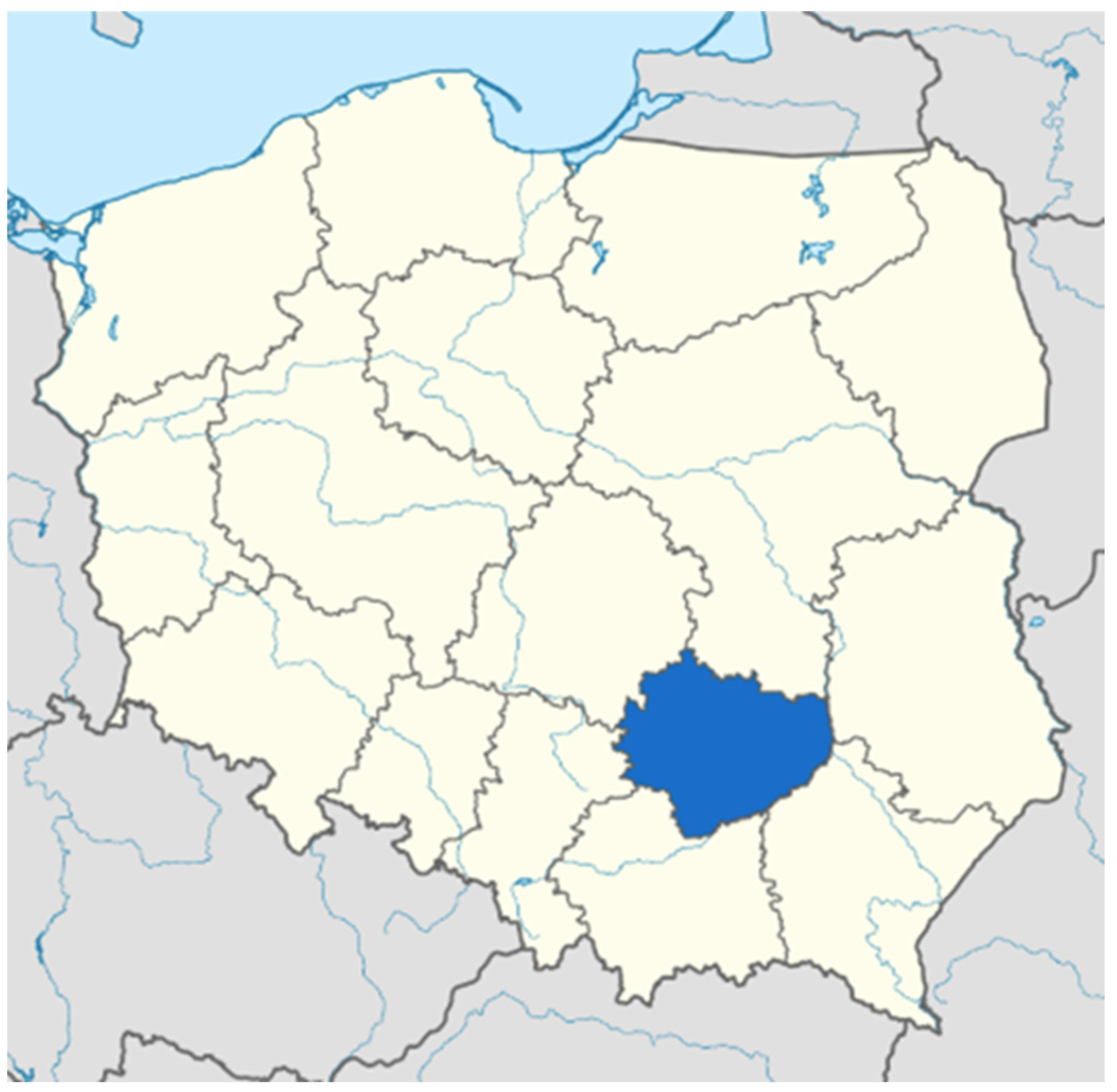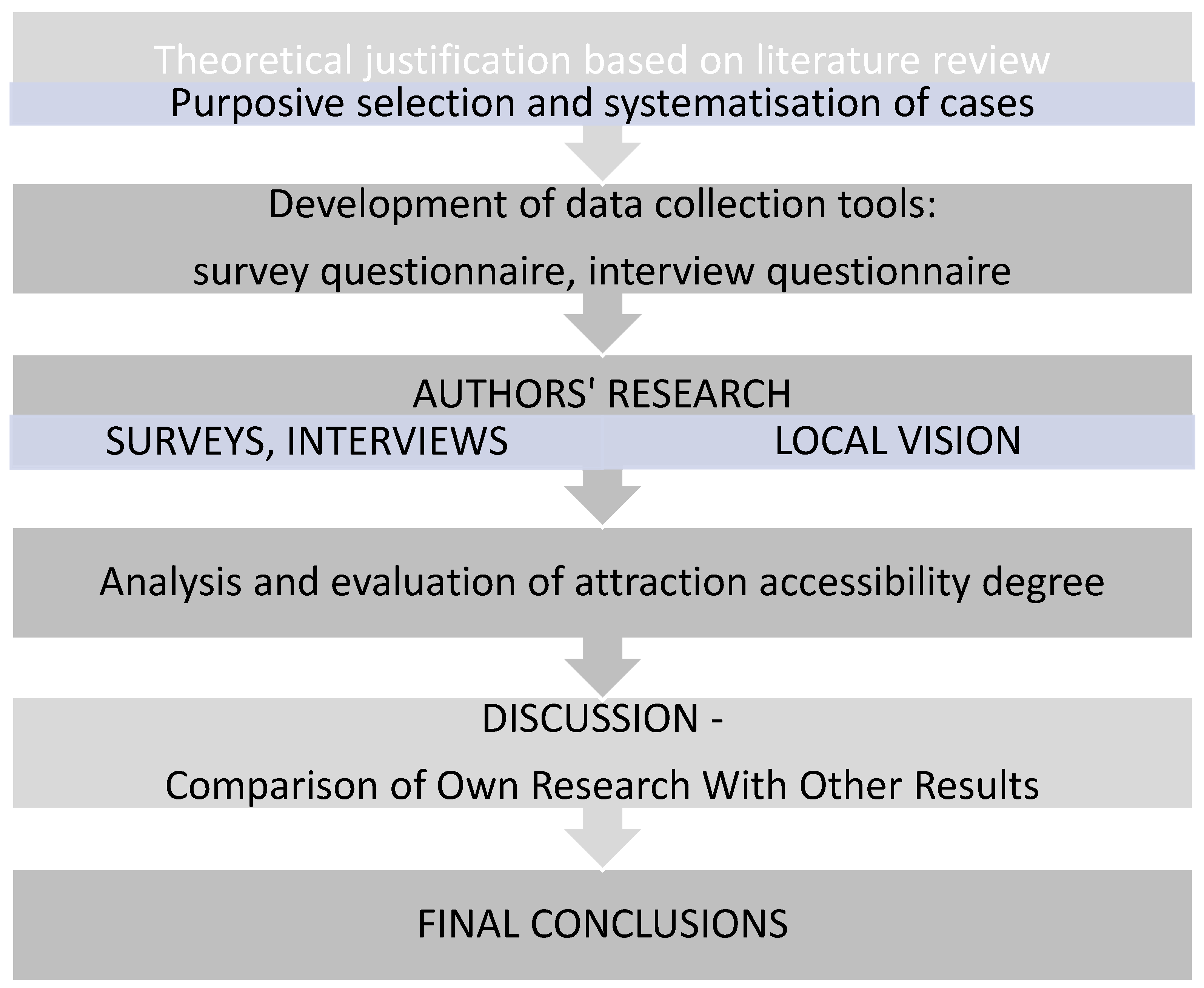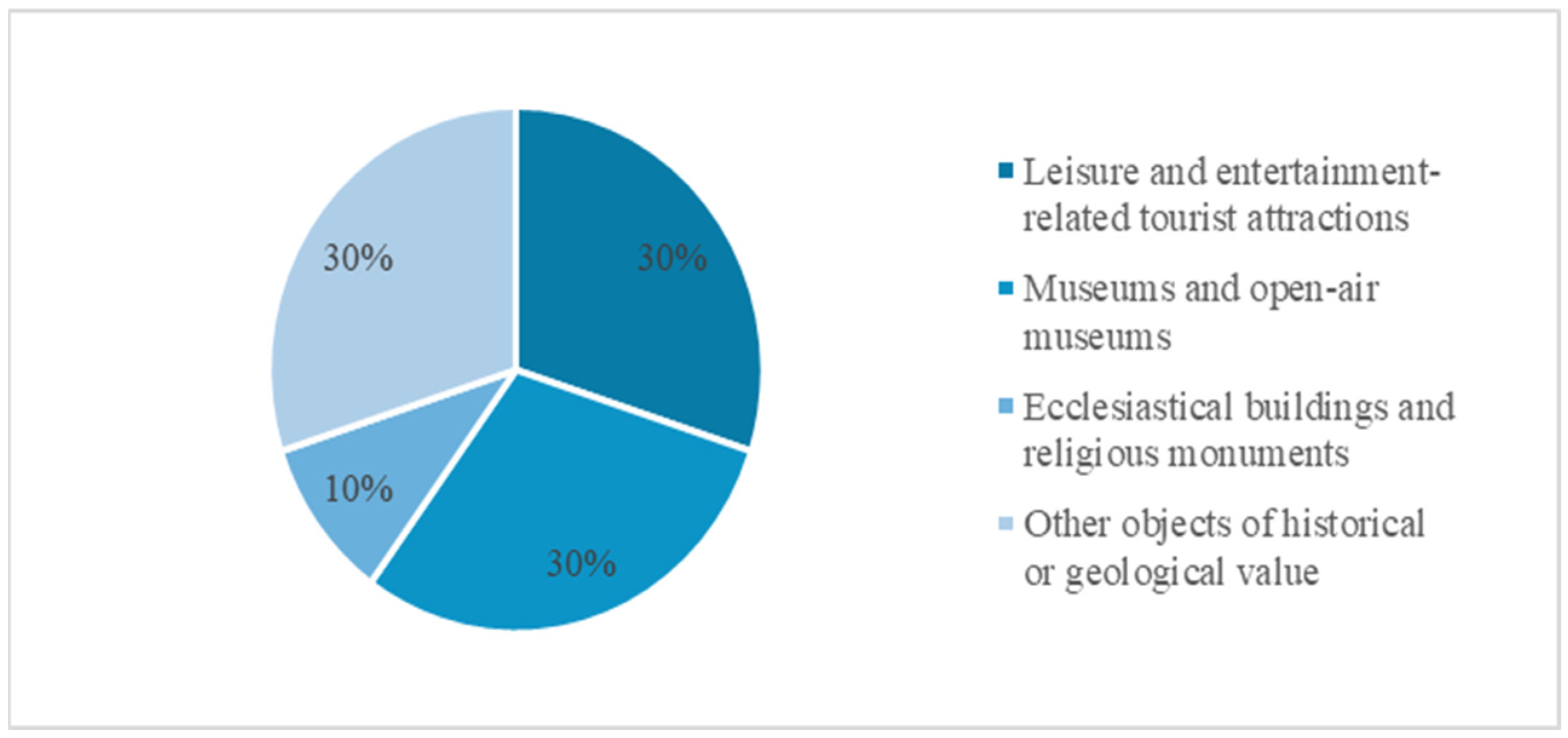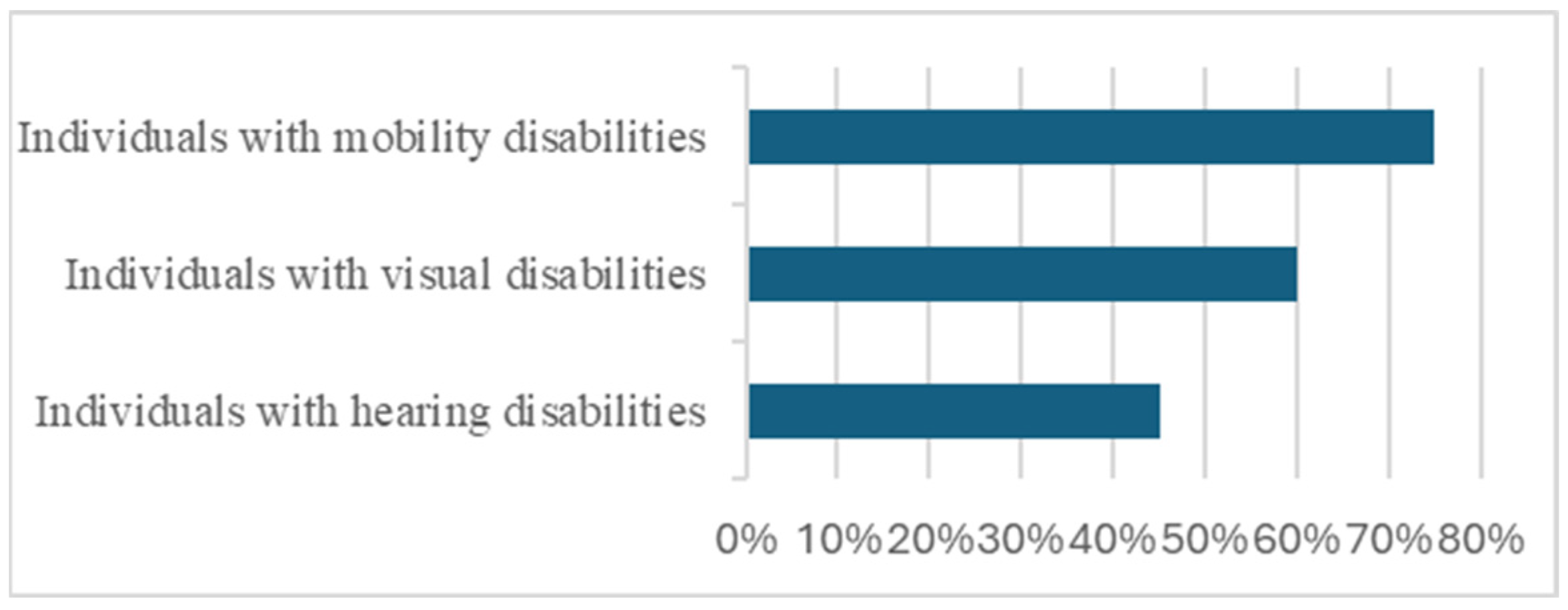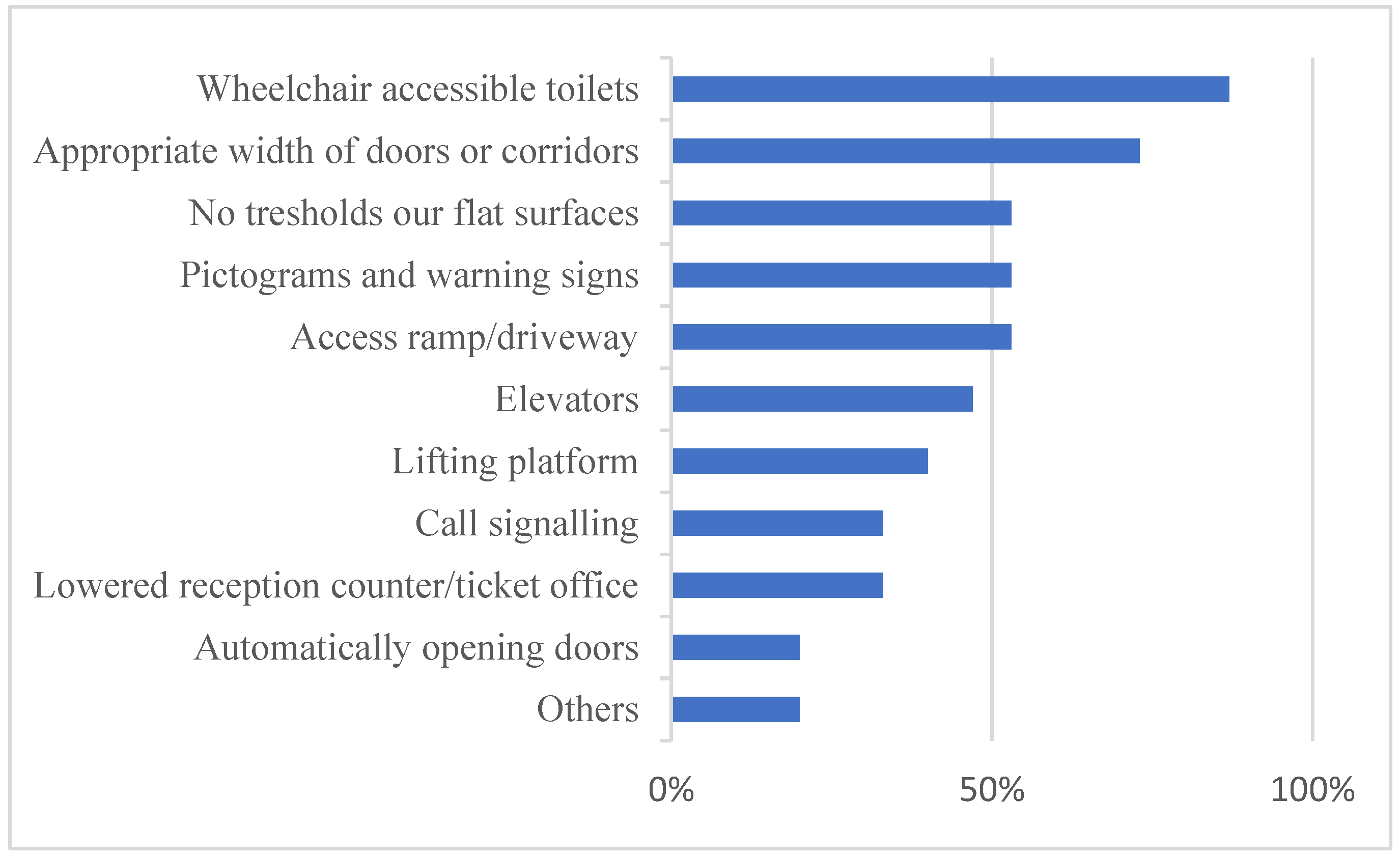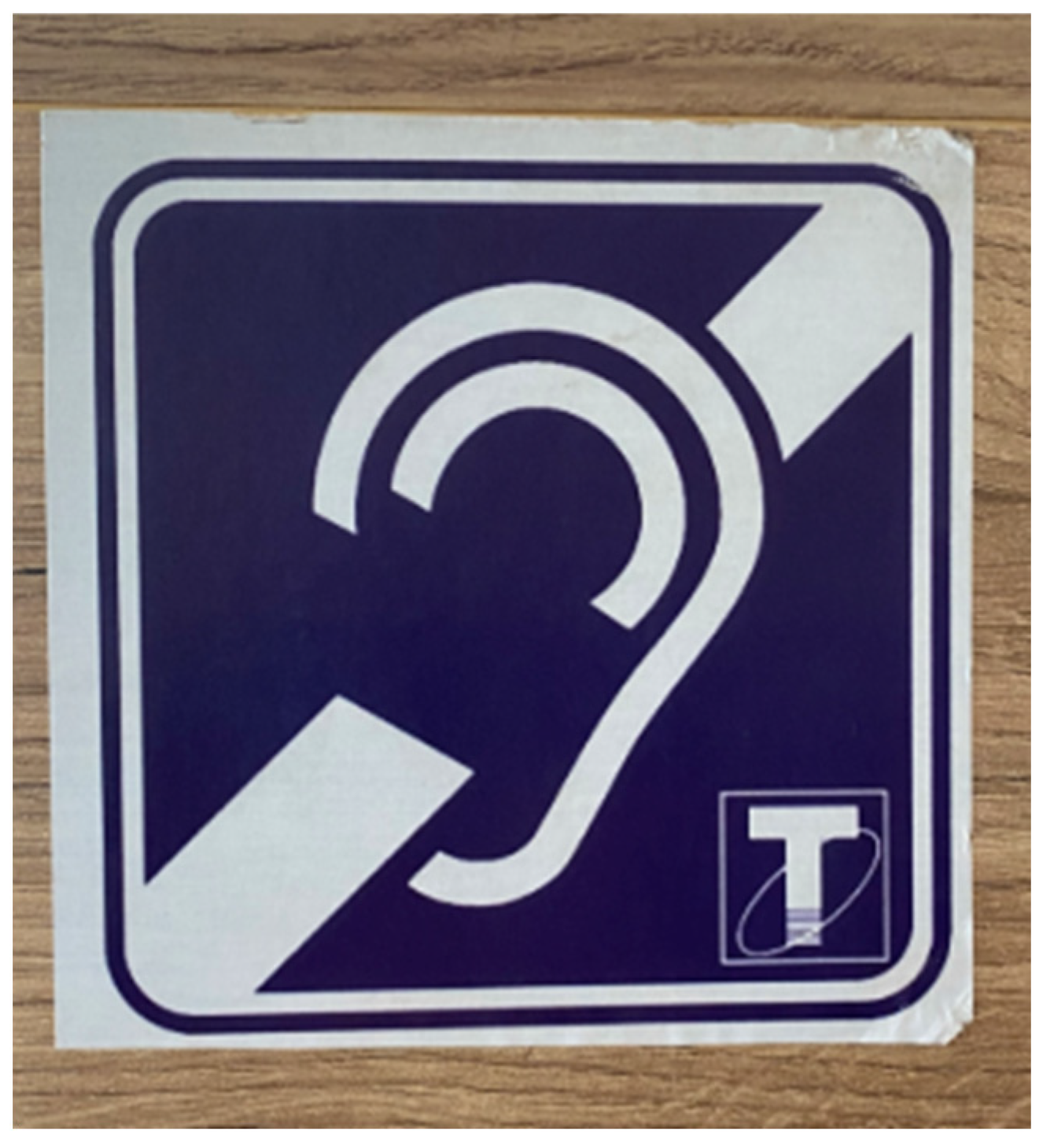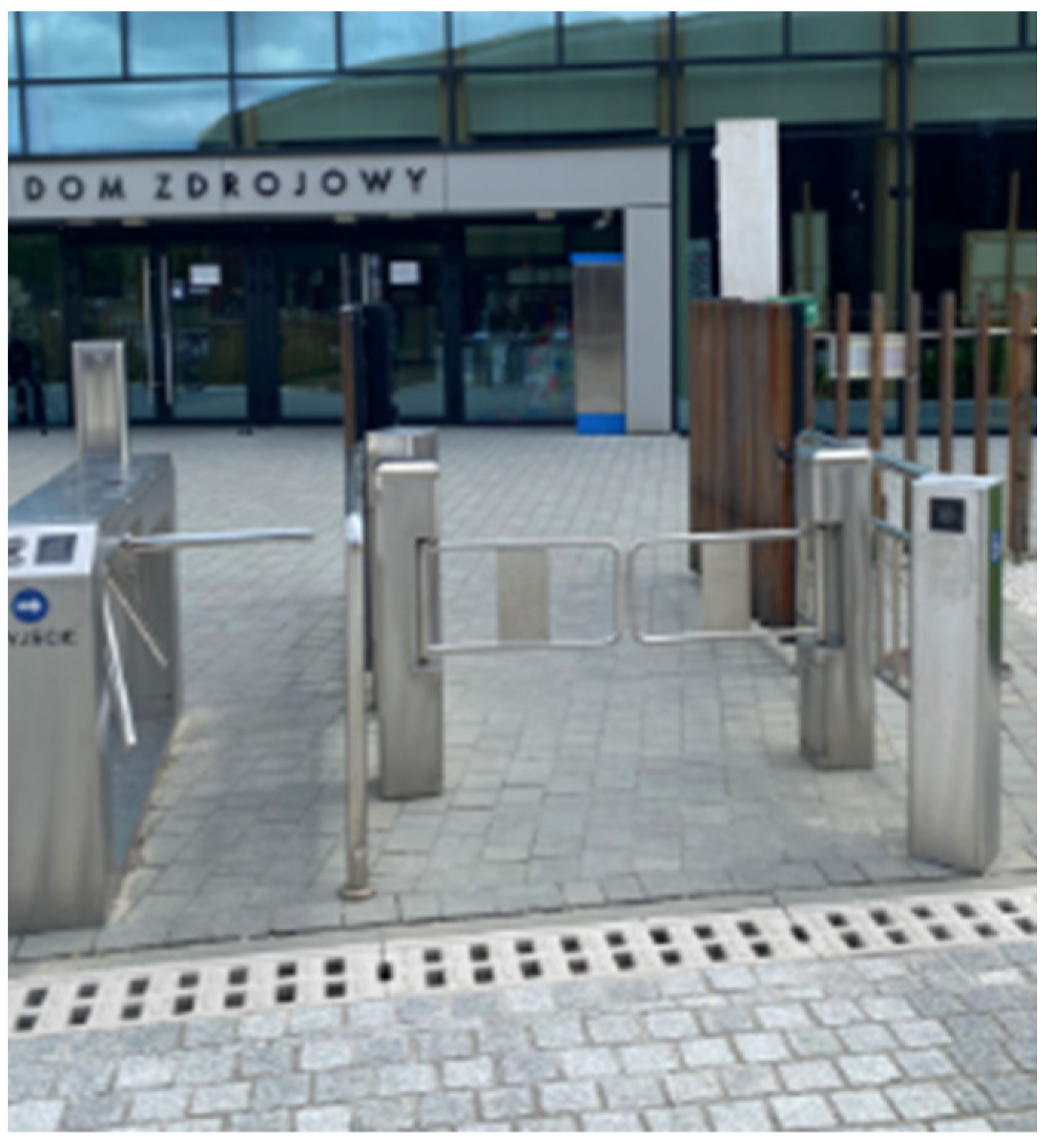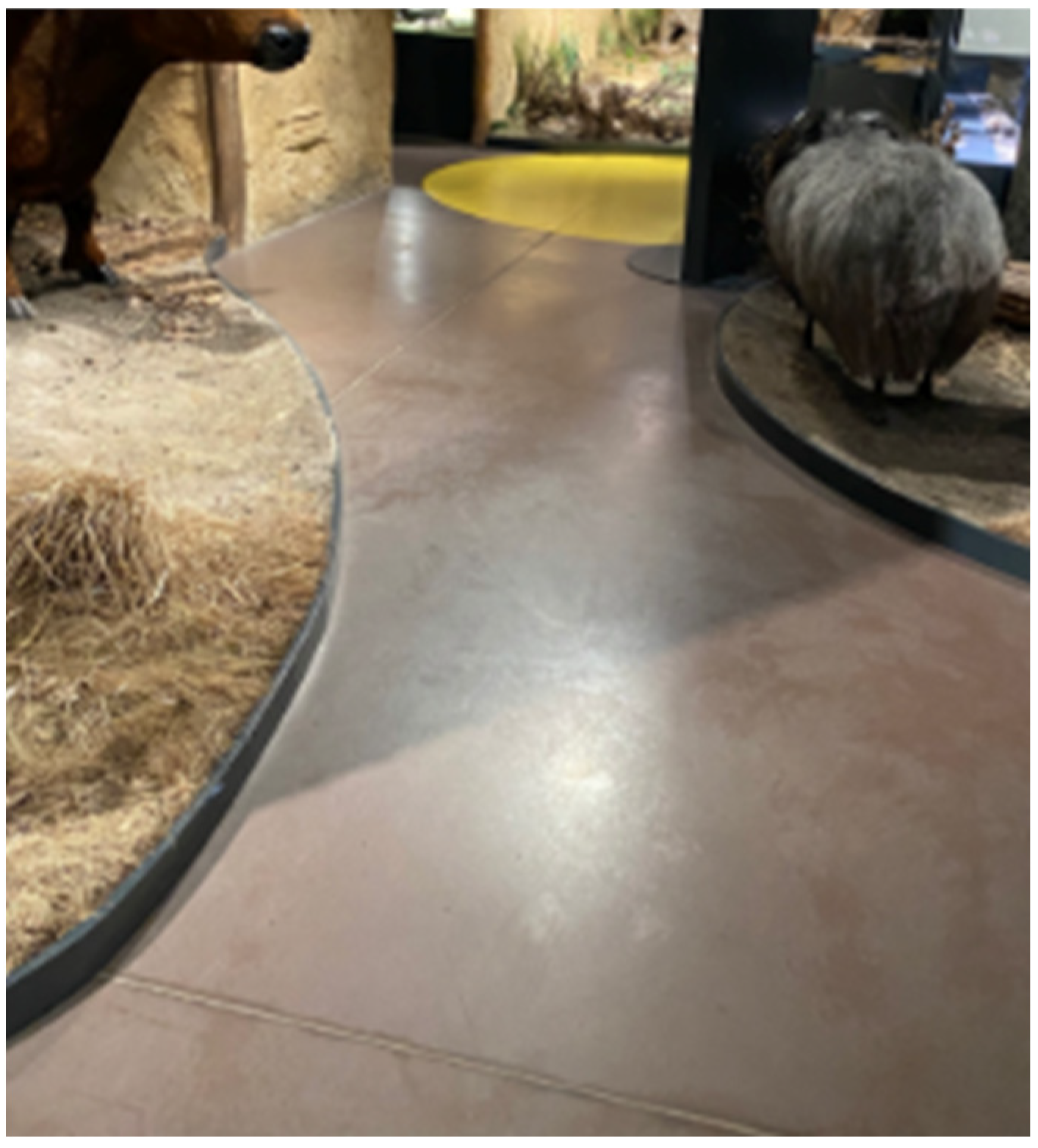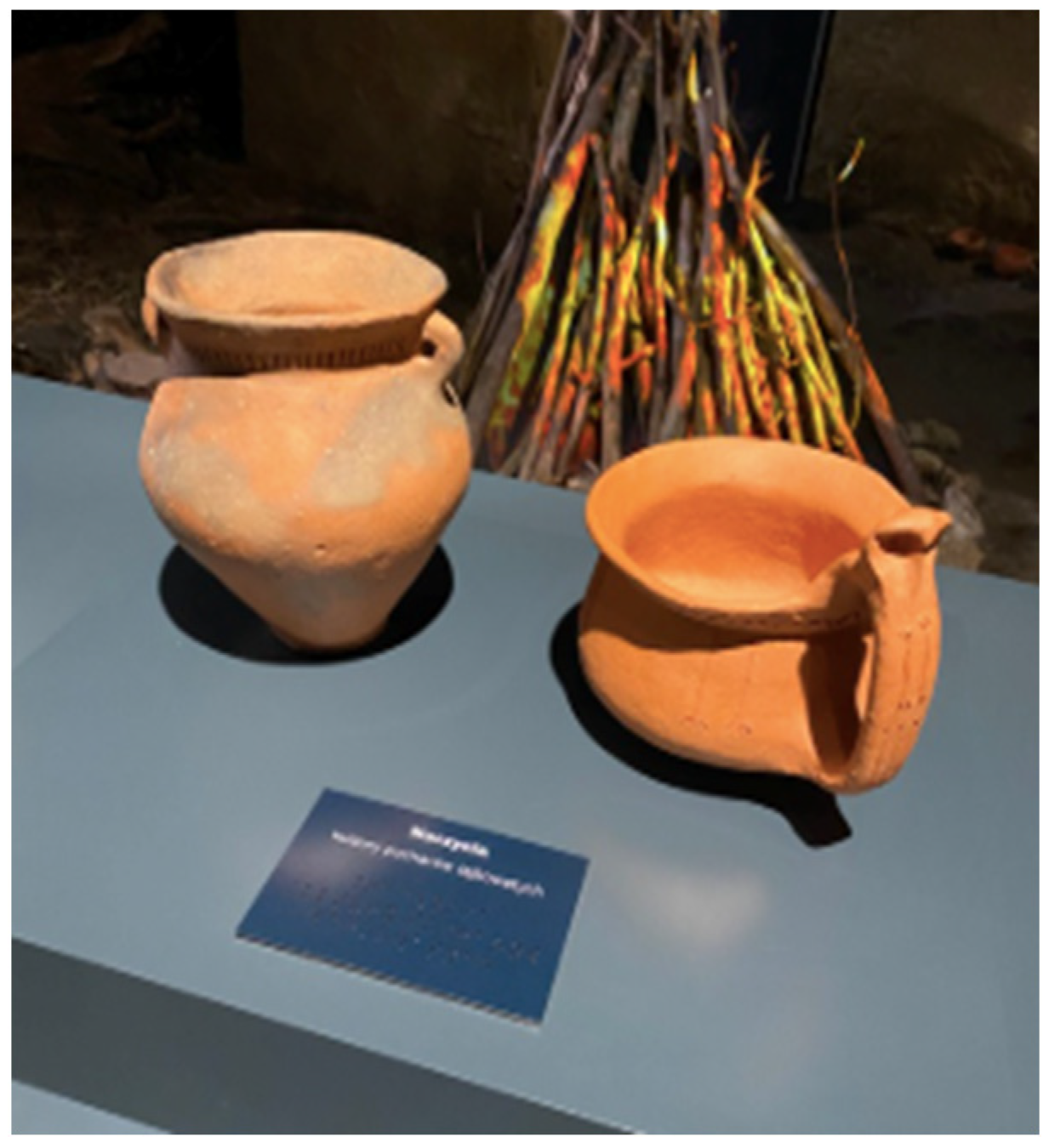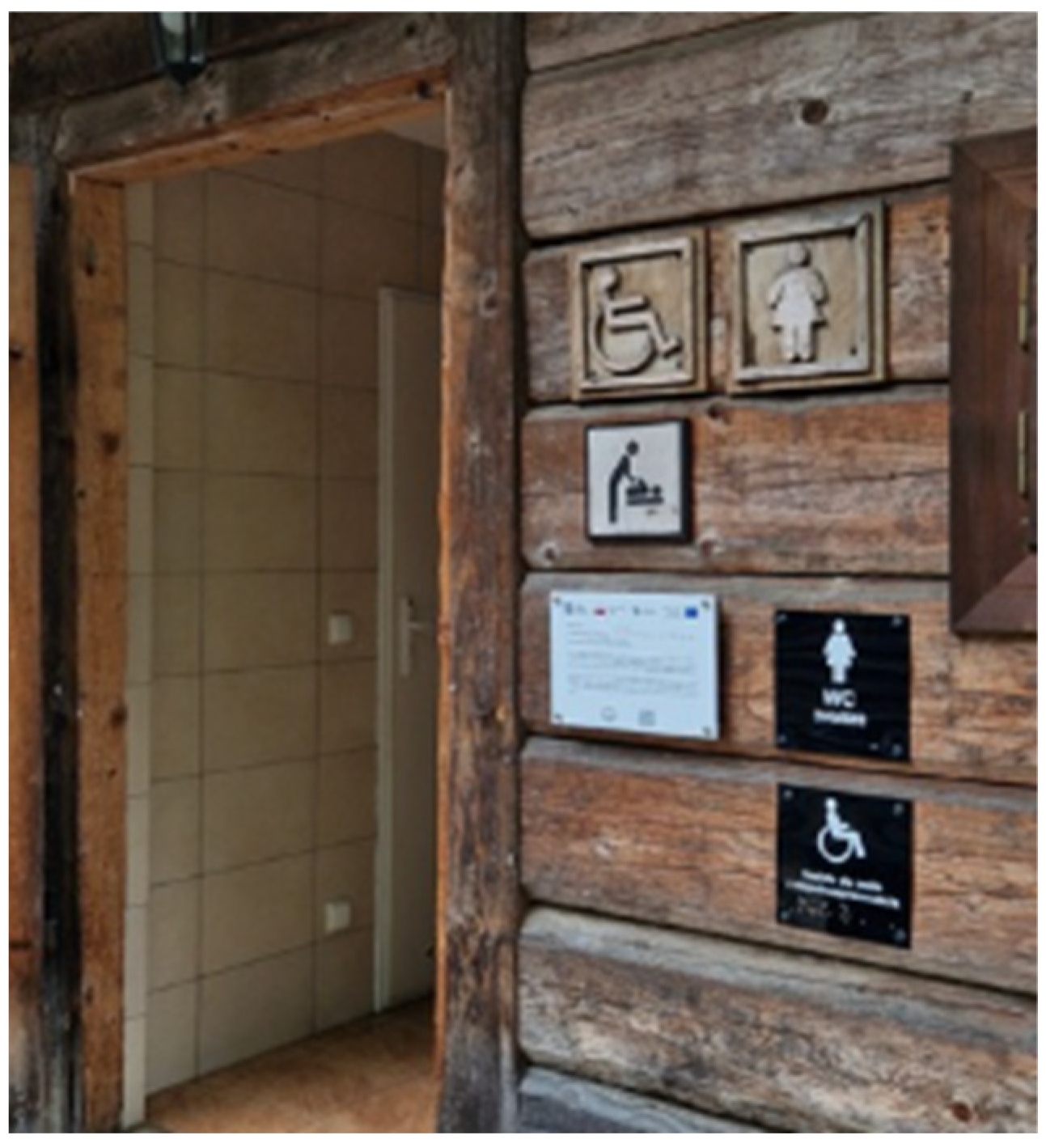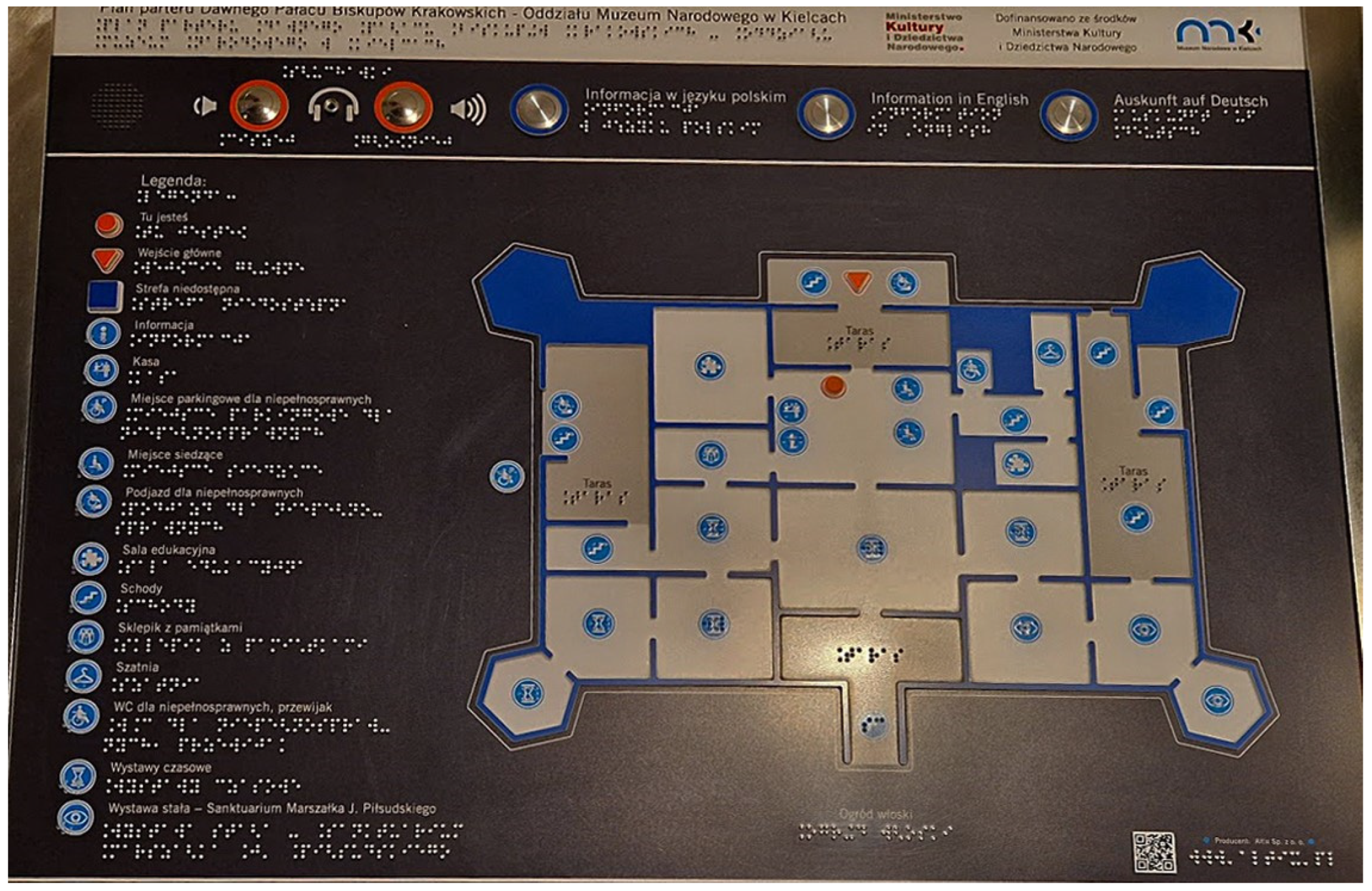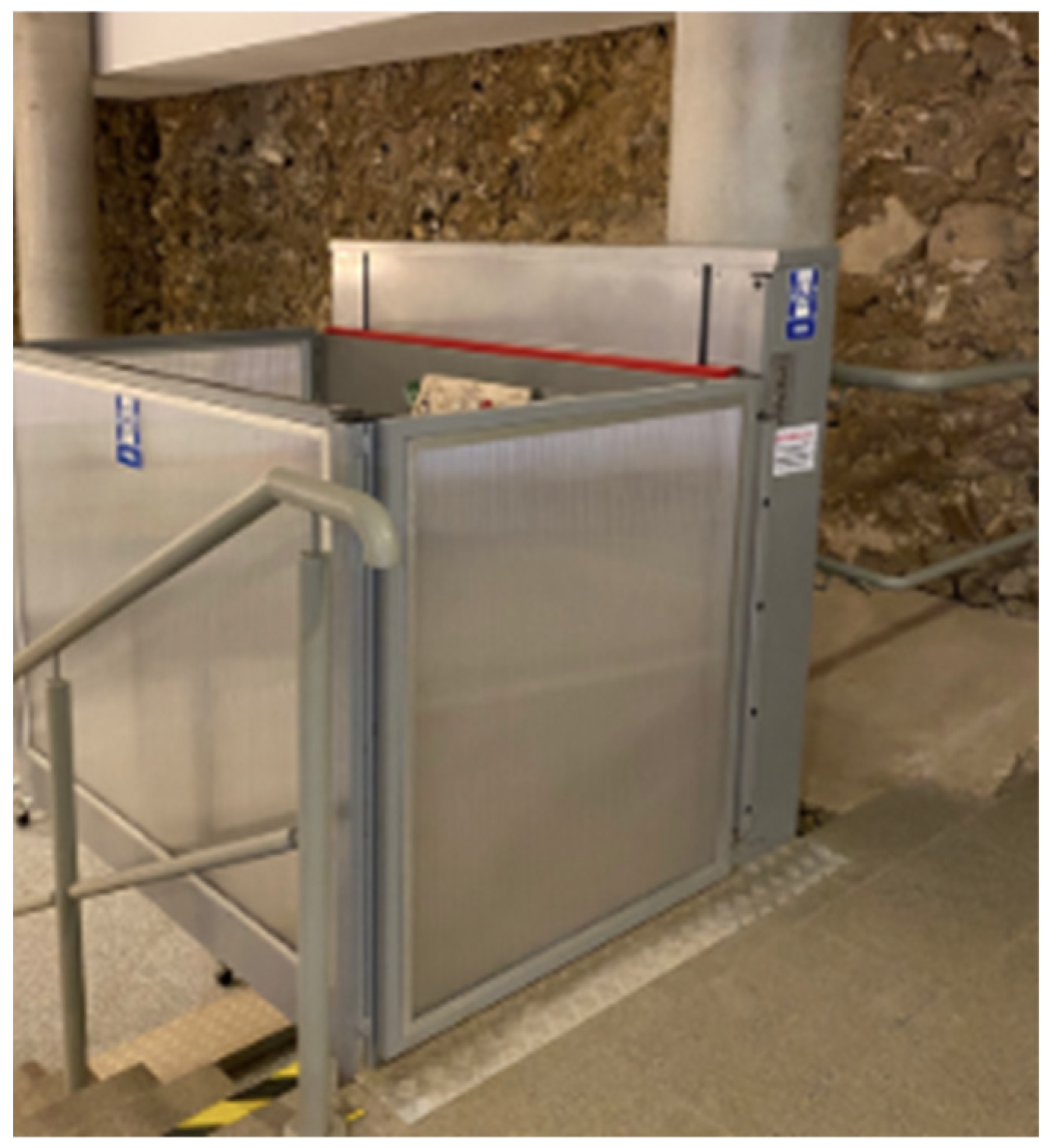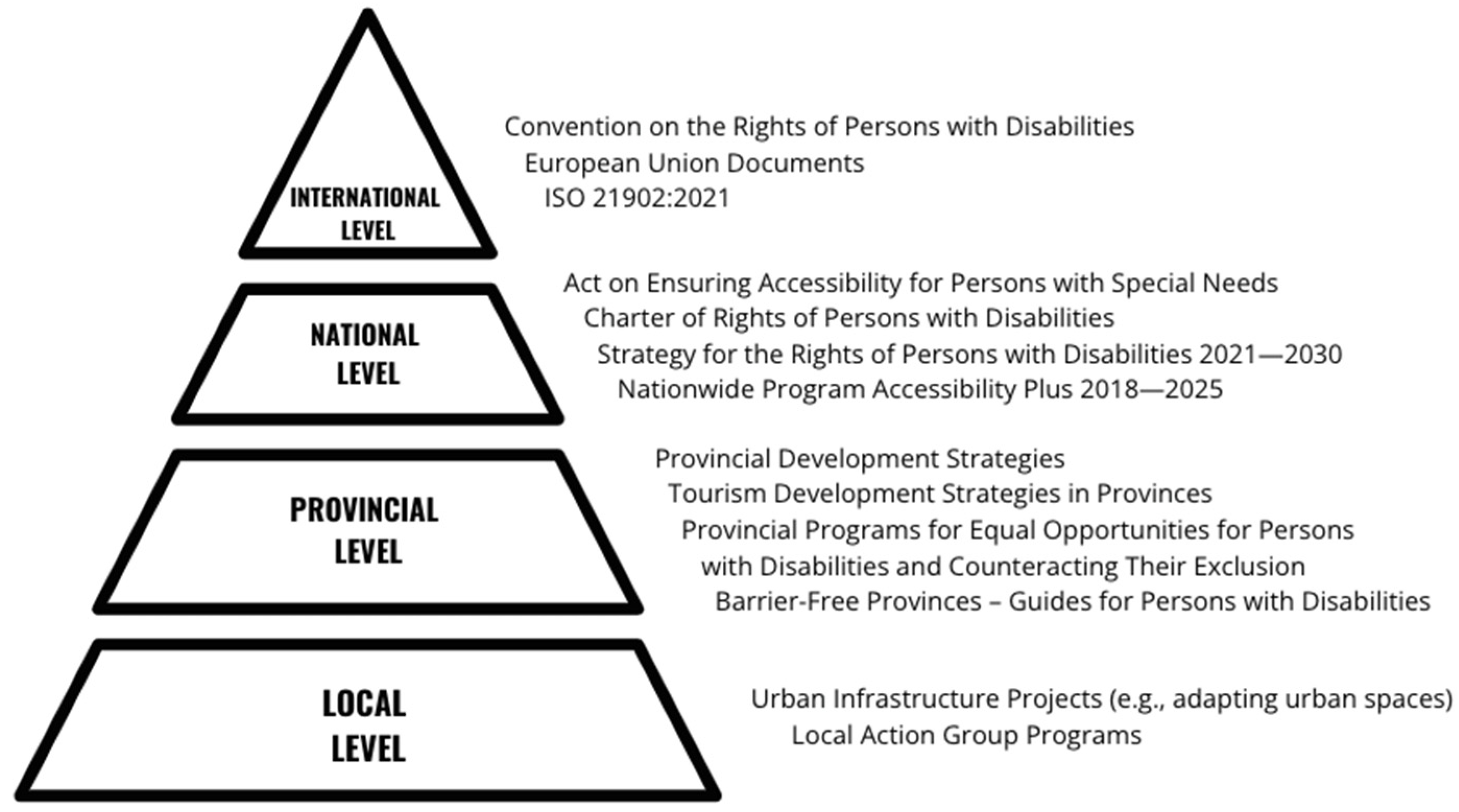1. Introduction
Currently, more than one billion people worldwide, or about 15% of the population, are affected by some kind of disability, and the number of individuals with various dysfunctions is increasing due to ageing populations as well as better diagnosis and assessment systems [
1]. The Convention on the Rights of Persons with Disabilities [
2], adopted in 2006 by the United Nations and ratified by all countries of the European Union, ensures the full inclusion of people from this group by increasing their participation in public spaces, including improved accessibility to various leisure activities. Accessible tourism is becoming increasingly popular, with more and more attractions, hotels, or restaurants declaring that they are open to the handicapped.
Changes in the perception of disability and a growing awareness of the barriers faced by people with special needs have made the accessibility of different spheres of life an increasingly important topic in public debate, calling for the abandonment of discriminatory practices against any groups of people who differ in any respect from the general public and for assistance to integrate them [
3]. The increase in the number of people who are officially recognised as having a disability is an important signal for politicians, planners, and businesses to adapt spaces to their needs. Physical activity, which includes tourism, is extremely important for people with special needs [
4]. In recent years, tourism has become an important way for people with disabilities to integrate and actively participate in society [
5]. Moreover, tourism and recreation are significant forms of rehabilitation [
6].
In the context of tourism, accessibility means providing equal opportunities to enjoy tourist services, which is important both at established tourist destinations such as Barcelona, Venice, Prague, or Kraków [
7,
8], but also those that are less recognisable but have great tourist potential, of which the Świętokrzyskie region is an example [
9].
The aim of this study is to assess the accessibility level of 20 leading tourist attractions in the Świętokrzyskie region for people with mobility, vision, and hearing disabilities and to propose actions aimed at improving this accessibility. This objective is part of the activities aimed at balancing the development of the region by including people with disabilities among the beneficiaries of tourism.
2. Literature Review
A review of the literature indicates that there are numerous terminological controversies regarding the topic of people with disabilities and the sphere of their inclusion in social and economic life.
The concept of disability is socially constructed [
10,
11,
12], and among the multitude of closely related words, those such as disability or handicap appear, which have a pejorative tinge and allow a negative social attitude towards persons affected by disability. The elimination of these terms should be at the heart of the fight against exclusion and discrimination. Also, the disability community demands to be referred to primarily by the term ‘person with a disability’, in order to emphasise that disability is one of the many special characteristics of a person and is a manifestation of human diversity [
6]. At the same time, it is a complex concept influenced by both personal and environmental factors (
Figure 1).
From the preamble of the United Nations Convention on the Rights of Persons with Disabilities, it follows, inter alia, that “disability is an evolving concept and (...) results from the interaction between persons with dysfunctions and the human and environmental attitudinal barriers that impede their full and effective participation in society, on an equal basis with others” [
13].
It is extremely important to consider the limited bodily capacity that determines disability together with the conditions of the environment in which the person functions. This relationship indicates that it is possible to improve the functioning of people with disabilities when changes are made to the environment, which involves the removal of barriers. It should be simultaneously emphasised that individuals with disabilities have the same needs as those without them [
14]; therefore, all democratic states should strive for social cohesion and the minimisation of inequalities by ensuring unrestricted access to public and commercial services provided by the private sector and municipal and state entities [
3]. Among these services, we find tourism, which is widely accessible to people with disabilities in high quality of life countries such as the Netherlands, Canada, the UK, and Scandinavian countries. The ‘VisitEngland’ programme in the UK, for example, promotes accessible tourism by certifying disability-friendly destinations and creating a comprehensive database of such facilities [
14].
The need for collaboration between stakeholders to enable people with different requirements—related to mobility, sight, hearing, and cognitive dimensions—to function independently with dignity is highlighted in many works [
15,
16,
17]. Such collaboration involves providing universally designed tourism products and access to spaces as well as services.
In research on accessible tourism, a variety of interrelated aspects related to travel are addressed, some of which concern transport [
16,
17] as well as the availability of accommodation [
18] and tourist attractions [
7]. It is also important for tour operators to note that people with disabilities often travel during the off-season, with at least one companion, and are willing to incur significant expenses for the trip. However, tourism for the disabled requires the creation of a special offer, profiled for different types of disabilities and having accessible attractions, accommodation facilities, and infrastructure in the reception regions. An example of an analysis of accessibility for people with disabilities on a local scale is the development of accessible tourism offers on the Istrian peninsula in Croatia [
19].
Accessible tourism is a growing field of research which examines how regions and tourist attractions accommodate individuals with disabilities. In several scientific studies, this topic has been explored across various contexts [
20]. In the case of Cape Coast and Elmina Castles in Ghana, the accessibility features of these historical sites were evaluated. While some amenities such as ramps and spacious pathways already existed, it was found in the study that the overall design of the castles did not fully align with accessibility standards as defined by disability legislation [
21].
The accessibility of tourist sites and attractions in Spain has been presented in the works by Rucci and Porto [
22] and Santana [
23], while Espinosa and Bonmatí have developed a guide related to the accessibility of museums and other sites on the UNESCO World Heritage List [
24].
In Poland, an analysis was conducted on the accessibility of tourist infrastructure for people with disabilities [
25], tourist attractions [
26], as well as tourist places and offers in the historic cities of Wrocław [
27] and Kraków [
7,
8,
28]. The accessibility of tourist facilities in the Liberec region (Czech Republic) was also assessed, formulating recommendations for tourist inclusion in the development strategies of this region [
29]. In Central European countries, the promotion of inclusive tourism is carried out by national tourist organisations, i.e., the Polish Tourism Organisation, which launched the “Poland Without Barriers” promotional campaign in 2022 [
30].
Experiencing the accessibility of historical heritage places by individuals living with visible and invisible disabilities allowed for investigations into the challenges faced by these persons when visiting historical heritage sites. This provided insights into the environmental barriers that hinder the full participation in and enjoyment of these cultural sites [
31].
The article “Making Cultural and Tourist Attractions Accessible and Inclusive for People with Disability Through Value Co-creation Amidst COVID-19: a Critical Discourse Analysis” examined how museums were adapted to become more inclusive during the COVID-19 pandemic. The importance of value co-creation between institutions and visitors with disabilities to enhance accessibility and inclusivity was highlighted [
32].
The COVID-19 pandemic period showed that the use of modern technology could effectively increase the accessibility of tourist attractions and especially museum facilities for people with disabilities. Smartphones with audio descriptors and the possibility of directly translating texts into sign languages or online communication tools are just a few examples of the use of technology to increase accessibility [
33]. These solutions have been used, especially in museums, which were mostly closed during the pandemic due to sanitary restrictions [
34].
These studies allow us to underscore the necessity for ongoing research and improvements in making tourist destinations accessible to all, ensuring that individuals with disabilities can fully participate in and enjoy cultural as well as recreational experiences.
4. Survey Results
4.1. Types of Facilities Used at Tourist Attractions
The main focus of the research was on accessibility at the facilities for the various groups with disabilities (
Figure 6). The largest number, 15 sites (75%), have facilities for people with mobility difficulties, 12 sites (60%) have located facilities for the blind and visually impaired, and nine attractions (45%) are adapted to the deaf and hearing-impaired (
Figure 6).
Among the facilities for people with mobility disabilities (
Figure 7), the presence of an adapted toilet and an adequate width of corridors as well as doors were most frequently found. Flat surfaces, pictograms, access ramps, and lifts are also common. Some attractions also have lifts, paging signals, or lowered counters. Unfortunately, only three (20%) venues had automatically opening doors, and other adaptations included a so-called stairlift and specially adapted buses for wheelchair users.
For the blind and visually impaired (
Figure 8), Braille descriptions and audio-description systems, including the use of beacons, have been incorporated. Four (33%) of the attractions included tiflographic plans. Only one (8%) attraction used contrasting colours and illuminated floor and ceiling mouldings. A textured surface signage system was also encountered once. An interesting solution was the use of information boards with QR codes.
An induction loop for people with hearing difficulties (
Figure 9) are found at seven (78%) facilities. At only two (22%) of the venues can we encounter video material in sign language. There are also videos with subtitles and the possibility to visit with a guide who speaks sign language, or an interpreter can be provided.
The majority of the surveyed facilities have a designated parking area, including flat access to the pavement. A problematic issue is the low percentage of staff who are trained to aid people with disabilities. Half of the staff are competent in this area at only 20% of the facilities. All facilities have their own websites, 58% of which are adapted for use by people with special needs and 63% of which contain information on the accessibility of the facility for people with disabilities.
Only two attractions have facilities for people with other types of disabilities in the form of a so-called ‘blue zone’ and an educational offer adapted to audiences with intellectual disabilities and autism spectrum disorders.
According to the custodians, at eight facilities, the said amenities were already planned at the construction stage, and at seven, modifications were necessary for their introduction. When asked about the reasons for not adapting the facility, the surveyed custodians most often indicated a financial barrier and the historic nature of the building, which requires the approval of the conservation officer. However, most of the attractions’ custodians declare that they want them to be made accessible and intend to make some effort to do so in the near future.
4.2. Assessment of Attraction Adjustment to the Needs of People with Disabilities in the Świętokrzyskie Region
In
Table 2, the authors present the previously mentioned division of selected Świętokrzyskie Voivodeship tourist attractions into four categories. Also given are the results of the assessment regarding the degree of accessibility for the three groups with disabilities. The number of visitors to these attractions in 2023 is also provided.
4.3. Attractions for Recreation and Entertainment
Six facilities were classified in the category related to leisure and entertainment. Of these, the best suited to accommodate all three groups of people with disabilities is the
Koziołek Matołek European Tale Centre in Pacanów. This children’s cultural centre has been in operation since 2010 and consists of a main building with an outdoor garden and the ‘Fairy Tale Academy’ Educational Park. A dedicated parking area is connected to the carefully designed circulation routes, which are of adequate width and have no thresholds (
Scheme 1). The mobility-impaired can use several adapted toilets. A special lift is also installed in the main building. During guided tours, there can be one wheelchair user per group, unless accompanied by an assistant, in which case, this limit does not apply.
An audioguide system is available during tours of the Fairy Tale World exhibition, upon prior notification of this need to staff. It is also possible to guide a blind person to a specific section. The centre has a website tailored to the needs of people with disabilities, which includes a switch to change the font size or alter the contrast. The website also comprises a detailed accessibility statement. There are instructional videos on how to navigate the entire centre in sign language. Induction loops have also been installed on site (
Scheme 2), but there is no possibility for guided tours in sign language.
The Mineral Pools in Solec-Zdrój are the only ones in Poland to use sulphurous healing water. They were opened in January 2013, so they are a modern investment. The sulphide brine, which is found in the Solec pools, has properties alleviating osteoarthritis and spinal diseases and analgesic properties, in addition to having a positive effect on the skin, making it more elastic. Due to the spa functions of this attraction, it has been adapted almost entirely to people with disabilities. There are ramps, lifts, toilets for people with disabilities, platforms, and lifts, as well as automatically opening doors. Specially adapted changing rooms are planned. In contrast, there is a lack of adaptations for the blind or visually impaired as well as the deaf and hearing-impaired.
In this category, the most popular attraction is the
Bałtów Jura Park, opened in 2004, which, after expansion, covers an area of approximately 100 hectares and is the most diverse in terms of types of attractions in Poland. Smooth movement is facilitated by numerous ramps and appropriate markings. Only in a few places is the presence of a strong attendant desirable. Lowered checkout counters and adapted toilets are a standard at the complex. A very interesting solution is to allow tourists to visit the Upper Zwierzyniec on board an American school bus (
Scheme 3). Out of the seven vehicles available, one is wheelchair-accessible and can accommodate five people with disabilities at a time. However, the facility does not have any adaptations aimed strictly at visually or hearing-impaired visitors.
The
Kadzielnia nature reserve has undergone revitalisation in recent years. The reserve has an amphitheatre, which regularly hosts cultural events (concerts, cabaret evenings) and an Underground Tourist Route, which can only be visited with a guide. A circular, flat trail runs through the reserve, which is adapted to the needs of people with impaired mobility—there are no stairs or other obstructions in the area, and a car park is provided that is adapted to their needs. Other facilities such as a toilet for people with disabilities are missing, and a section of the path is gravel, which can be a problem after heavy rainfall due to the unstable surface. The wheelchair learning track should be highlighted, which was the implementation of the winning idea created by the Kielce Civic Budget. The track allows wheelchair users to practise moving around in different conditions, as well as practising overcoming the obstacles they have to face in their everyday life [
40]. Unfortunately, the facility is not adapted to visually and hearing-impaired visitors. Despite assurances from the attraction’s operator about the presence of tiflographic signs and Braille descriptions, these could not be found during the verification visit.
In 2012, the Sabat Krajno Miniature Park was established at the foot of the Łysica Mountain, which is an extensive leisure and entertainment complex. The park is partially adapted to the needs of people with impaired mobility. Flat paths, lowered counters, suitably adapted toilets, and a stairlift enable tourists in wheelchairs to reach the furthest parts of the Miniature Park, as well as to enter the restaurant. Unfortunately, it is located on a hill and the steep slope when viewing the miniatures can be a problem for wheelchair users. The park has no adaptations for the blind or visually impaired, but some miniatures can be touched. The park has no adaptations for the deaf or hearing-impaired.
The
graduation tower in Busko-Zdrój, built in 2020, is one of the largest and most modern brine graduation towers in Poland. Among all the surveyed facilities, it has by far the most comfortable automatically opening doors and specially adapted gates (
Scheme 4). On the first floor, there is an observation deck from which the panorama of the health resort can be enjoyed. However, it is inaccessible for people with mobility difficulties, as several stairs have to be climbed. These stairs are the only barrier, as once they have been climbed, for example, with the help of a stairlift, the upper floor is fully accessible, as it is flat and wide. The health house, with its pump room and year-round mini graduation tower and orangery, is accessible to people with mobility difficulties, as are the graduation tower’s surroundings in the form of park greenery. The facility does not have any facilities aimed at the blind and visually impaired or the deaf and hearing-impaired.
4.4. Regular and Open-Air Museums
Regular and open-air museums comprise another category represented by six sites in the surveyed collective. It is worth noting that this is the only site from the Świętokrzyskie region, i.e., the
Krzemionki Prehistoric Striped Flint Mining Region, inscribed on the UNESCO World Heritage List in 2019 [
41]. The site has undergone refurbishment to make it more accessible to individuals with disabilities. It has many facilities for people who have mobility problems (
Scheme 5). Specially designated and signposted parking spaces, adapted toilet facilities, and the adjustment of the width of the exhibition halls are present. A special, shorter section of the underground tourist route has been dedicated to people in wheelchairs, which can be accessed by a lift located within the Zenon shaft. Visually impaired visitors have the opportunity to touch replicas of the monuments while visiting the permanent exhibition (
Scheme 6). Large print and Braille inscriptions have also been placed. This exhibition is also audio-visualised, using granular paint that can be felt underfoot. Multimedia kiosks present an expanded version of information about the exhibition. A guided tour of the site is possible, but there is no sign language interpreter available, and despite the significant adaptation of the exhibitions in the main building, exploring the reserve in the open air and inside the mine is considerably difficult for people with sight and hearing difficulties.
The Kielce Countryside Museum is an Ethnographic Park in Tokarnia, founded in 1976. Its adaptation to the needs of people with mobility impairments was rated at two points. There are toilets for people with disabilities, flat paths, a wide entrance, and a car park with pavement. A handicap is related to the single thresholds leading to some exhibits, which are an architectural barrier due the original architectural design of the historic buildings. In addition, the uneven terrain can make it difficult to navigate in a wheelchair, especially during bad weather. However, it is possible to use ramps to access selected facilities.
This attraction is well-adapted to the needs of visually impaired visitors, mainly due to the project ‘Adaptation of the Kielce Countryside Museum’s offer to the needs of the blind and visually-impaired’, carried out in 2020. It has a number of facilities with, e.g., Braille signs at every object in the park (
Scheme 7), signs on the toilets and ticket offices, and tri-fold guides available for free hire at the ticket office, which enable a blind person to learn the shape of the buildings depicted in the museum. In addition, a sensory chamber has been opened in the museum where replicas of the exhibits can be touched, and three types of dedicated educational activities have been introduced for blind and partially sighted people. Furthermore, staff have been trained to assist this group of customers. The museum is a little less well-prepared for hearing-impaired visitors, as the only item that can be mentioned here are miniature receivers together with earphones for the hearing-impaired (DLR-01R) available ‘upon request’. It is also worth noting that the museum has a good website and a detailed accessibility statement.
Another flagship of the Świętokrzyskie Region is the
Henryk Sienkiewicz Museum in Oblęgorek, the palace that the Nobel Prize-winning writer received as a gift from the nation in 1900. A ramp allows wheelchair users to access the ground floor, where there is also a toilet for people with disabilities. There are no architectural barriers on the ground floor. Unfortunately, the stairs to the first floor prevent people with mobility impairments from seeing the museum exhibition. An excellent audio-description programme has been developed for visually impaired visitors (
Scheme 8), and induction loops have been provided for people with hearing disabilities. In this museum, according to the auditors, the staff are by far the best prepared and trained to inform and assist individuals with disabilities.
The
National Museum in Kielce is a multi-departmental institution with a 100-year tradition. Accessibility studies were carried out at the former
Krakow Bishops’ Palace in Kielce. It is a residence with original 17th- and 18th-century interiors. The museum offers a number of facilities, such as adapted lifts, toilets, a ramp, and a staircase platform. This allows a person in a wheelchair to visit the Palace Interiors and the upper floor of the Gallery of Polish Painting and European Decorative Arts. The museum received only one point in the assessment of adaptation to the needs of the blind and visually impaired. Such a low score is due to the lack of Braille descriptions and other adaptations in the exhibition area, and only a single tiflographic board with a description adapted to the needs of this group, which is located on the ground floor, near the ticket offices (
Scheme 9). For the hearing-impaired, induction loops have been installed and sign language video material is available.
The Mieczysław Radwan Museum of Ancient Świętokrzyskie Metallurgy in Nowa Słupia was opened in 1960 to protect an archaeological site, revealing the relics of 45 bloomeries. The building has been extended several times and in 2016, it was transformed into a modern facility with a number of adaptations for people with disabilities. This museum achieved the maximum rating for adaptations to people with mobility impairments, with wide corridors, a lowered counter in the reception area, and lifts and toilets adapted to the needs of people with disabilities. A person in a wheelchair can reach any part of the museum. It is worth mentioning the adaptation of the website to the needs of the blind and visually impaired (special contrast adjustment, possibility to listen to the content of the website by a voiceover) and the deaf (valuable information provided). Within the museum, it is possible to borrow an audio-description system, as well as listen to a voiceover describing the exhibition. Unfortunately, other adaptations are missing. The situation is similar in the case of facilities adapted to the hearing-impaired and the deaf, where, apart from subtitles on the screened films, there are no other accommodations.
The Sandomierz Castle Museum, on the other hand, is not accessible to people with disabilities. However, it is worth noting that the museum’s manager is aware of the problem and an accessibility audit has recently been carried out as well as efforts to obtain funding from the European Funds for Infrastructure, Climate and Environment 2021–2027 programme to adapt the facility to people with special needs.
4.5. Sacral Monuments
Research was conducted at two religious sites that are particularly popular with visitors. The Łysa Góra Monastery was visited by more than 320,000 people in 2023; the shrine has been an important centre of Christianity for many years. The site, due to its location and historical value, is not adapted to people with mobility impairments. A special parking space has been prepared, but there is no pavement, and the multitude of thresholds and stairs make it difficult for a person in a wheelchair to move around the monastery. Despite this, people with mobility impairments visit the sanctuary every day or several times a week. The staff is characterised by a great willingness to help, demonstrating an empathetic approach to visitors, but this does not compensate for the lack of real adaptations. The facility does have some adaptations for the blind and visually impaired—these include Braille boards and tiflographic plans. It is worth mentioning the facility’s well-designed website, which is adapted to the needs of people with visual impairments. The facility does not have any adaptations for the deaf or hearing-impaired.
Better adapted to the needs of people with disabilities is the Sanctuary of Our Lady of Sorrows Queen of Poland in Kalkowo-Godów. A person using a wheelchair can easily access the main parts, including the chapels and places of worship, thanks to an access ramp and flat surfaces. The surroundings of the sanctuary, which include the Stations of the Cross and the mini zoo, are also manageable for people with mobility difficulties. The three-story building dedicated to Pope John Paul II, which hosts numerous cultural and religious events and provides accommodation for pilgrims, has a lift and a call sign. Unfortunately, one of the most important attractions, i.e., the Lourdes Grotto, is completely inaccessible to the disabled due to the numerous stairs. There are some Braille descriptions and induction loops for those with sight and hearing problems. The hosts of the site have declared that they do not intend to introduce any new adaptations in the near future.
4.6. Other Historical and Geological Sites
The final category is made up of sites that do not fall into any of the previous three categories but are undoubtedly a showpiece of the region. One that stands out is the Royal Castle in Chęciny, which was probably built at the turn of the 13th and 14th centuries and now has the status of ‘permanent ruins’. The facility is not suitable for visitors with mobility impairments. It is accessed by a series of steep stairs. It has one adaptation for the blind and visually impaired, i.e., QR codes. The QR codes, however, are not convex or guided by a system of textured surface badges, which can make it very difficult for a blind person to find the code. The facility does not have any adaptations for the deaf or hearing-impaired.
The ruins of
Krzyżtopór castle in Ujazd are the remains of one of the largest palace buildings in Europe, built between 1621 and 1644, before Versailles. Despite its historic nature, it has several facilities for the mobility-impaired. Special parking spots are located right next to the ticket offices. The courtyard of the château is gravel but flat, and it is possible to move between levels by means of a lift and lift platform (
Scheme 10). An additional toilet has also been provided. Unfortunately, access to the basement is not given to people who are unable to climb the stairs themselves. This historical monument is not ready for the blind and visually impaired, and only an induction loop has been provided for those with hearing difficulties.
The Neolithic Settlement in Kopiec, opened in 2020, is well-adapted in terms of accessibility for people with reduced mobility. As part of the ‘Accessible Tourism in the Municipality of Iwaniska’ project, a number of measures have been taken to make the site friendly for all visitors. Special paths have been prepared for people with mobility impairments, allowing them to move between the reconstructed buildings, and checkout counters as well as toilets have been adapted. For visually impaired visitors, the settlement offers guides to assist and support them, providing verbal descriptions of the exhibits and the opportunity to touch some of the objects for a fuller historical experience. The guides, nonetheless, are not prepared to work with deaf and hearing-impaired visitors.
The Raj Cave, located in the Świętokrzyskie Mountains, is one of the region’s best-known tourist attractions, although it is a nature reserve with limited access. Tours take place in groups with a guide. Due to the nature of the cave environment—narrow corridors, high humidity, and low temperatures—it is very difficult for people in wheelchairs to experience this site. The only adaptation is the sanitary facilities. It was declared that a parking area is planned. There are no special assistive devices for the blind or visually impaired. The guides conduct the tour in narrated form, which can be a challenge for people who have a hearing impairment.
Two attractions located in Sandomierz were also included in this category—the Underground Tourist Route was under renovation during the audit and reaching the ticket offices was difficult. The attraction includes historic cellars, corridors, and chambers up to 12 metres underground, and is not easy to navigate for people with limited mobility because of the numerous stairs, level differences, and narrow passages, as well as the lack of any facilities. There are no facilities for the blind or deaf. The Opatów Gate is also not adapted to the three disability groups surveyed to any extent. Visitors wishing to reach the ticket offices and information desk encounter an architectural barrier in the form of a steep staircase right from the start.
5. Actions for Inclusion of People with Disabilities in the Świętokrzyskie Region
The problems of people with special needs are addressed at different levels of governance (
Figure 10). From the perspective of international law, one of the most important documents is the Convention on the Rights of Persons with Disabilities [
2]. However, the way in which individual countries implement the recommendations contained at the highest levels is of extreme significance [
42]. In Poland, Article 32 of the Constitution guarantees the right to equality, including the provision of equal opportunities and prohibition of discrimination, while according to Article 69, people with disabilities are to be provided with support from the state [
43]. The topic of inclusion is addressed in the Act on Ensuring Accessibility for Persons with Special Needs [
44] and the Charter of Rights of Persons with Disabilities [
45].
The Strategy for Persons with Disabilities has been developed for the 2021–2030 period, and a National Accessibility Plus Programme is in operation for the years 2018–2025. Documents at the provincial level include Provincial Development Strategies and also Tourism Development Strategies for their area. At the same time, provincial programmes aimed at equalising opportunities for people with disabilities and counteracting their exclusion are being created, as well as dedicated guides.
Social inclusion is also a challenge for the tourism industry, in which services for seniors are indicated among the predicted trends, alongside luxury services, experience tourism, and sustainable, environmentally and climate-friendly services [
47]. It should be emphasised that the involvement of multiple stakeholder groups is needed to provide universal solutions. Actions at the local level are extremely important, as this is where the real effects of actions become most visible, e.g., a municipal infrastructure project adapted to people with disabilities is the ‘Barcelona Accessible’ project [
48]. It allowed for the introduction of a range of solutions such as upgrading architectural barrier-free spaces, a low-floor bus fleet, and digital accessibility tools. As has been rightly pointed out, there is a wealth of publications on disability and accessibility of tourist attractions in various regions of Poland [
8], but there is no comprehensive overview regarding the Świętokrzyskie Region [
49].
In the Świętokrzyskie Region, under the Act on Ensuring Accessibility for Persons with Special Needs, there is a Social Council for Persons with Disabilities, which is primarily responsible for providing an opinion on draft resolutions and programmes adopted by the Voivodeship Council in terms of their impact on handicapped individuals [
50]. Creating favourable conditions for people with disabilities has found a place in the Strategy for Tourism Development in the Świętokrzyskie Voivodeship 2014–2020 [
51] and in the Świętokrzyskie Voivodeship Development Strategy 2030+ [
52]. Selected objectives and activities that are related to the inclusion of people with disabilities in tourism in the studied region are presented in
Table 3.
In both Strategies for the Development of Tourism in the Świętokrzyskie Voivodeship for 2014–2020, priority directions of actions are addressed to people with disabilities, such as, among others, improving communication accessibility, eliminating architectural barriers, as well as ensuring digital and information accessibility. In terms of social policy, the programme has been written down for the equalisation of opportunities aimed at persons with disabilities and counteracting their social exclusion, as well as assistance in the implementation of tasks for the employment of people with disabilities for 2021–2026 [
52]. Funding is also provided in the case of projects dedicated to improving accessibility for people with disabilities. These investments include upgrading public infrastructure, adapting public buildings, and developing accessible transport services and public spaces. Funds are earmarked for eliminating architectural barriers, introducing facilities for people with reduced mobility and improving digital accessibility [
53]. As part of the project ‘Improving the accessibility of tourist information about the Świętokrzyskie region for people with disabilities’, the Świętokrzyskie Regional Tourist Organisation carried out training dedicated to the staff of Tourist Information Centres and Points on serving tourists with disabilities, and adapting websites, including
https://swietokrzyskie.travel/ (accessed on 28 February 2025), to the needs of people with disabilities, in accordance with the WCAG 2.0 standard at the AA level [
54]. As part of this project, an audioguide was created, mainly aimed at blind people, which presents the biggest attractions of the voivodeship [
53]. As early as 2009, a guide for the disabled, ‘Świętokrzyskie without barriers’ [
55], was developed, which included suggested routes intended mainly for people with impaired mobility, but unfortunately, due to a number of changes, including new admission prices and renovations of sites, such as the rebuilding of Krzemionki Opatowskie, these suggestions were not introduced. This guide differs in content from those for other regions in Poland, such as Kraków [
56] or the Silesia region [
57].
Physical and mental fitness is an important part of human well-being; therefore, preventing disability and social exclusion should be in everyone’s interest. With increasing computerisation, there is an opportunity to design new technological solutions aimed at people with disabilities, such as beacons. This is a technology that promotes equal opportunities and helps, among other things, to collect and transmit information, the use of which translates into communication and navigation, including in the case of tourism [
11].
Actions devoted to increasing the level of participation of people with disabilities in tourism and recreation have positive impact on both the physical and psychological spheres of people with disabilities [
25].
6. Discussion
The tourist attractions that were taken into consideration for this article were chosen intentional. Both valid tourist organisations in this Voivodeship, Regionalne Centrum Informacji Turystycznej w Kielcach [Regional Centre for Tourist Information in Kielce] and Portal Informacji Kulturalnej województwa świętokrzyskiego [Portal for Cultural Information on the Świętokrzyskie Voivodeship], highlight 20 tourist attractions that are most popular and most worthy of a visit in this region. The authors based their choice of tourist facilities on the above lists and introduced changes that were more compatible with other scientific articles on accessible tourism—which introduced more diversity at the chosen sites. The change in the choice of facilities is subtle—it was decided to include more museums that are usually more accessible for people with disabilities, and to exclude some tourist routes, trekking paths, or viewpoints. This minor change allowed us to compare some exceptional adaptations, or their lack, of sites that can logically prepare them instead of focusing on trekking routes that are not adjusted to people with special needs.
The first research question that was intended to be answered in this article concerned whether the main attractions of the Świętokrzyskie region are accessible to people with disabilities, and for which types of disabilities facilities have been created. The conducted research allows us to indicate that the level of adaptation regarding selected tourist attractions to the needs of different groups with disabilities varies. None of the surveyed facilities are fully ready to accommodate people with disabilities related to mobility, vision, or hearing impairments. Recreation and entertainment attractions with the highest attendance are the best adapted to those who are mobility-impaired, but there is a lack facilities for the visual- and hearing-impaired. Regular and open-air museums are by far the best adapted to people with visual and hearing impairments. At other facilities, fewer are dedicated to this group of individuals, indicating the need to increase efforts for their inclusion. In the case of people with visual impairments, it is worthwhile to introduce guides who would provide assistance and support, providing verbal descriptions of exhibits and the ability to touch certain objects, enabling a more complete historical experience. Guides should be prepared to work with the hearing-impaired, providing sign language interpretation or detailed visual and textual explanations, among other things. The staff preparation for welcoming people with disabilities is not satisfactory. This was one of the main issues in the current study—there were some minor difficulties in communicating with business owners, facility managements, and staff that worked at the places considered in the research. There was a slight lack of understanding concerning the obstacles that people with disabilities have to endure daily, and sometimes, a lack of empathy or willingness to introduce changes on behalf of this group of potential tourists. Fortunately, this situation was observed in the definite minority of the examined places.
Confronting the obtained results with those achieved in other studies on Krakow’s flagship attractions, it appears that museums are by far the group of attractions best adapted to accommodate tourists with disabilities [
8]. Comparing the two surveys, in both the Małopolska and Świętokrzyskie regions, it is found that the facilities at the attractions are mainly appropriate for people with mobility impairments, and much less so adapted to the needs of people with sight and hearing impairments. In a 2010 comparison of tourist facilities adapted to the needs of people with disabilities, the Świętokrzyskie region did not perform well (only 3% of facilities have such adaptations) [
58]. It was also noted to have the lowest density of adapted tourist routes for individuals with disabilities compared to other regions [
59]. In the present study, significant improvement is shown in this respect, with significant changes being made to the accessibility of tourist facilities in recent years. The renovation of the Krzemionki Opatowskie Underground Route, the opening of modern museums such as the Museum of Ancient Metallurgy in Nowa Słupia or the Legends Park, as well as the renovation and upgrading of the route around the Kadzielnia Nature Reserve, are just a few of the many tourism development measures for the region in 2019–2024. Consequently, the tourist accessibility of the region for people with disabilities has significantly increased.
The second research question aims to more thoroughly describe the degree of attraction accessibility for people with disabilities.
The degree of the accessibility of tourist attractions in the Świętokrzyskie region for people with disabilities varies and depends on the type of limitations faced by visitors. However, none of the surveyed facilities are fully adapted for any of the analysed groups. The surveyed attractions are best prepared for people who have mobility problems, to a lesser extent for the blind and visually impaired, and the least for the hearing-impaired and deaf. The main barriers to adapting the facilities are due to financial constraints and the need to preserve the historic character of the buildings (for example, in the Sanctuary of Holly Cross Relict, the parish priest was very willing to introduce changes in order to make the church more accessible, but it was not allowed to because of the historic value of the Sanctuary), which often requires the approval of a preservationist. Despite these difficulties, many attraction managers say they are willing to further improve accessibility, which can contribute to the inclusiveness of tourism in the region.
The accessibility of tourist attractions is one of the foundations of action towards increasing the social inclusiveness of people with disabilities. The importance of social inclusion is confirmed by a decrease in unemployment among the disabled, as well as an increase in economic activity [
60] and the employment rate in this group. This indicates an increasing need for self-realisation and independence among people with disabilities, which may manifest itself in a desire to meet needs in other areas as well. Tourism has a positive impact on maintaining activity, improving cognitive function, fulfilling the need to explore, and generally improving well-being in seniors [
61]. Among them, the handicapped comprise a large group; thus, adapting tourist attractions to their requirements will undoubtedly enable them to realise their need to explore the world without fear for their own safety or health [
62].
There is a need to assess the adaptation of facilities to meet the needs of people with intellectual disabilities and those with special needs related to neurological developmental disorders such as autism. These groups also represent a significant proportion of society and continue to experience social exclusion [
63]. Disability should not define a person, as the medical approach does, as a passive recipient of support; disabled persons should be equal members of society [
62]. Therefore, barriers need to be removed by introducing practices aimed at including these groups and counteracting their isolation from society [
64]. One such practice would be to enable this group to enjoy the benefits of tourism by adapting tourist attractions to their special needs. Tourism for the intellectually disabled is an important therapeutic element. It allows for the development of interpersonal contacts and for more complete social integration [
15]. Therefore, there is a need to continue research among other groups of people with disabilities.
Creating accessibility to tourist attractions is one way to increase the attractiveness or competitiveness of a tourist destination [
65,
66].
Such an opportunity for the Świętokrzyskie region is unanimously perceived by all local stakeholders, i.e., local authorities, the tourism industry (managers of attractions, accommodation and catering facilities, tourism organisers), and above all, people with disabilities.
Indeed, the development of inclusive tourism aims not only to expand access to consumption, production, and benefit sharing in existing tourism destinations, but also to redraw the tourism map to create new places of experience and interaction [
67]. Inclusive tourism encompasses a wide range of actors in a variety of settings seeking to expand the circle of people involved in tourism creation, tourism consumption, and tourism benefit sharing. In many cases, these initiatives involve new geographic areas of tourism [
68,
69]. Taking the above into consideration, there is a third research question that needs to be addressed: what measures are being taken to improve the accessibility of tourist facilities for people with disabilities? The problems of people with special needs are included in the development strategies of the Świętokrzyskie region. Priority courses of action relate to improving communication accessibility, eliminating architectural barriers, and ensuring digital as well as information accessibility. In terms of social policy, a programme to equalise opportunities for people with disabilities and prevent their social exclusion is being implemented. Funding is also provided for projects that improve accessibility for the disabled. Also, the vast majority of business owners declare the desire to introduce more changes and innovations to benefit people with disabilities. Some facilities, such as Muzeum Wsi Kieleckiej [Kielce Country Museum], have certain plans to arrange a special space for people with autism, and some sites are willing to organise training for staff in order to prepare them to assist people with disabilities better. These changes that appear to be insignificant or small at first glance, are indeed the first signs of changing the approach to treating people with disabilities.
7. Conclusions
In recent years, the number of people with disabilities in the world and in Poland has been steadily increasing, and changing attitudes towards this group of people and growing awareness of the barriers they face have made accessibility to various spheres of life, including tourism, an increasingly important issue. This is evident in the policies pursued at various levels, where attention is paid to measures that create the accessibility of infrastructure and services for all citizens.
Research on the accessibility of tourist attractions for people with disabilities enriches the multidimensional image regarding the issue of inclusion in tourism. Tourism plays an important role not only as a form of physical activity, but also as a tool for social integration and rehabilitation. In the context of the Świętokrzyskie region, which has significant tourism potential, the issue of adapting the main tourist spots to the needs of people with disabilities takes on particular significance. Many custodians pointed to financial barriers and limitations due to the historic nature of the sites as major obstacles to fully adapting the attractions. These constraints are particularly difficult to overcome in the case of historic sites, where the need to preserve the authenticity of historic buildings often interferes with the introduction of modern amenities. It is encouraging that creating accessible spaces is now a standard at the planning stage of new facilities.
Another significant problem revealed in the survey is the inadequate training of staff in supporting people with disabilities. For the surveyed facilities, a low percentage was found of staff with adequate competence in this area. In a small number of cases, staff were adequately prepared, which underscores that the implementation of comprehensive training programmes to better serve and ensure the comfort of all visitors is a must. In places where modern technologies such as audio-description systems, induction loops, and beacons have been used, clear benefits for people with disabilities have been observed. These technological innovations have significantly improved the quality of tours, indicating the potential for further implementation as an effective tool in improving the accessibility of tourist attractions. A growing awareness of the need to improve accessibility and a willingness to make changes was also determined at many sites. The custodians’ declarations regarding future plans indicate a positive attitude towards the integration of people with disabilities, which is a promising sign for the future development of tourism in the region.
In conclusion, the results of the survey suggest the urgent need to continue efforts to improve the accessibility of tourist attractions in the Świętokrzyskie region. Improving accessibility will not only affect the quality of life of people with disabilities but will also contribute to the attractiveness of the region, which may have long-term economic and social benefits. Increasing the number of tourists from this group will not only provide economic benefits but will also improve the perception of the region as a modern and inclusive place, ready to welcome all visitors, regardless of their disabilities. In order to achieve these goals, it will be necessary to further engage local authorities and tourism facility managers in implementing strategies for the inclusion of disabled individuals.
